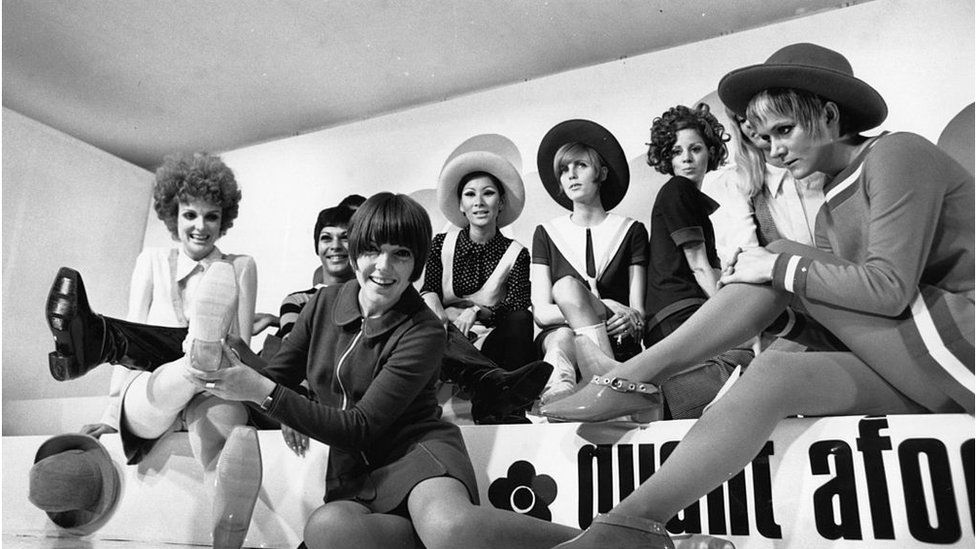ARTICLE AD BOX
 Image source, Getty Images
Image source, Getty Images
Mary Quant launches her waterproof boot collection in 1967
By Annabel Rackham
BBC News
Mini skirts, shift dresses and PVC are three fashion staples you'll spot in any high street store - but they probably wouldn't exist without Dame Mary Quant.
She will be remembered as one of the most innovative designers in British history, after her death aged 93.
Quant changed women's fashion forever with her vision of chic clothes that provided both comfort and practicality.
Her aesthetic was influenced by the dancers and musicians who hung around in London's Chelsea, and the Mods who were synonymous with London's youth culture in the late 1950s.
Mods, short for modernists, wore Italian sportswear rather than structured clothes, something Dame Mary replicated in her first collections.
She wanted those who wore her clothes to feel relaxed in them - rather than outfits for big occasions, her clothes were designed for everyday life.
Image source, Getty Images
Image caption,Mary Quant's popular white plastic collar look added depth to jumpers and dresses.
The appeal of her clothes for a new generation of women who wanted to shake off the shackles of post-war utility clothing.
Dame Mary once told the Sunday Telegraph that after World War Two, there were "10 years of gloom and despair, when London was a bomb site".
"Nothing moved, nothing happened. And then suddenly the next lot of young people said, 'Enough of this, we're going to do it,' and they did it themselves," she said.
Skinny rib jumpers and hot pants
As a self-taught designer, she had gained her sewing skills from evening classes and would produce clothes that would then go straight on the rails at Bazaar, a boutique she opened in Markham House on the Chelsea's King's Road in 1955.
She'd take the money she made from a day on the shop floor and use it to produce new lines that would be made overnight and stocked the next day.
Her signature styles included short tunic dresses with bright tights, white plastic collars for jumpers and dresses, plus weatherproof plastic boots.
Image source, Getty Images
Image caption,Mary Quant looks at a window display in her Bazaar store on King's Road, London in 1960
They gained international appeal thanks to the model Dame Lesley 'Twiggy' Lawson, whose long legs and petite frame were perfect for Quant's short hemlines.
Twiggy paid tribute to Quant on Thursday, saying she "revolutionised fashion" and that "the 1960s would have never been the same without her".
Quant created the knitted skinny rib body-hugging jumper and is even credited with designing hot pants for the first time in 1966.
Dame Mary wasn't afraid to try new materials and used polyvinyl chloride - better known as PVC or vinyl - to manufacture wet-look clothes like dresses and raincoats.
Her 1963 Wet Collection was a huge success and earned Quant her first British Vogue cover, with model Tania Mallet wearing a PVC red raincoat and matching hat.
This YouTube post cannot be displayed in your browser. Please enable Javascript or try a different browser.View original video on YouTube
The BBC is not responsible for the content of external sites. YouTube content may contain adverts.
Photographer David Bailey, who captured much of the spirit of London in the 1960s, told the BBC that Quant "was so nice about me".
"She said I'd like my pictures to look like Bailey and I like to control them a bit, but she liked all those jumping pictures," he added.
Bailey, 85, also said he was "sad" about Dame Mary's death, saying: "She was kind of wonderful, she was very positive."
The mini-skirt is born
Although there's some dispute about who actually invented the mini-skirt (French designer Andre Courreges says the thigh-skimming hemline was his creation) the name was Quant's alone.
The skirt is well-known for sitting well above the knees, normally at mid-thigh and would be paired with colourful tights.
Skirts of this length had only been acceptable in sports like tennis and figure skating before this point, but became the height of fashion for young women and teenagers as a result of Quant's influence.
She named the skirt after her favourite car and said it was invented by "the girls on King's Road" in a 2014 interview.
David Bailey, 85, with some of the pictures he took of Mary Quant
The skirt, like a lot of her clothes, was designed to let you "run and dance" and enjoy "freedom and liberation".
By 1967 she had three shops - two in King's Road, Chelsea and one in London's New Bond Street.
She had also experimented with cosmetics, creating the Daisy brand and a cheaper, nationwide fashion offering called Ginger Group.
It was estimated that up to seven million women had at least one Mary Quant fashion item with thousands more using her make-up.
Throughout the 1970s her influence grew - with her business growing to include home décor, swimwear, jewellery and even skincare for men.

 2 years ago
53
2 years ago
53








 English (US) ·
English (US) ·